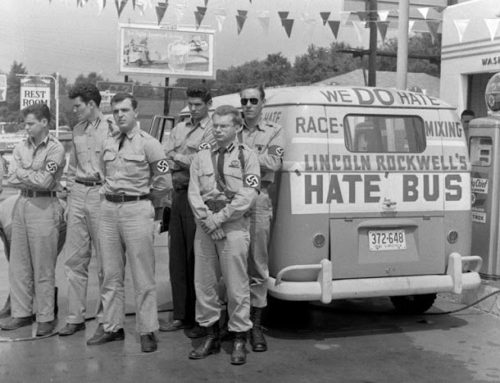I’m going to let you in on a secret: as I write my new business book this summer, I’m going to post most of it here, in the raw, first draft form. If you’ve got thoughts or feel you can add to the story, please do. Either leave a comment below or send me an e-mail. The book is titled Branded to the Bone and it’s about great companies who are true at every touch point, whose brand integrity leads them to develop great customer loyalty and great results for their employees, their shareholders and their world.
So hold on to your hats because here we go.

Branded to the Bone
Preface
Here’s how it happened for me: I came home one day when I was 37 years old and found a message on my answering machine. I pushed the button and there was the voice of Don Runkle, then the Chief Engineer at Chevrolet, asking me to call him.
It’s hard to paint the picture of how unlikely that call was. Six months earlier, I had quit my job at the fast-growing start-up I’d helped put on the prestigious Inc. 500 (Inc, Magazine’s list of the nation’s fastest-growing companies). I quit because I was badly in need of a change. I was sick of going to the office, irritated with the corporate politics, bored with the work I was doing as a marketing manager and feeling, desperately, that my skills and talents weren’t being used.
I wanted a purpose and I wanted to write. Not because I thought I had something to say but because I thought I’d go crazy if I didn’t. And it’s not that I hadn’t been trying. For ten years, I had written anything anyone would let me. I’d written song lyrics for musician friends and jokes for comedian friends. I’d written magazine articles and short stories. I’d written ad copy and brochures. I’d edited a yoga magazine and a newsletter on employee screening.
I even responded to an editorial in Road & Track magazine about Chevrolet and their brand problems with an article proposing to explain just where the Chevy brand had gone wrong. Stupid, I know. No wonder Road & Track never got back to me.
But Chevrolet did.
“Road & Track sent us this article you wrote,” Runkle told me. “We just want to know who you are. We’ve been trying to articulate this for years. How do you know so much about our brand?”
The answer was, I’d been paying attention. I still had a young boy’s passion for anything with wheels. By the time I was six years old I could identify almost every car on the road, even from a mile away. As a teen-ager, I tried to rebuild the engine on a Chevy pick-up truck I bought (and learned one more thing on the list of things I wasn’t born to do) and in the preceding few years before I quit my management job, we had a small fleet of mid-‘80s Chevy Cavalier sedans and Blazer SUVs.
In the article I compared one of those SUVs to a the 1955 Chevrolet sedan my family owned when I was a child and to another ’55 Chevrolet Bel-Air a friend and I had driven cross country when I was an adult.
I wrote of my childhood impressions of the Chevy, saying “To me, the color and texture of that car, the feel of it, was like a public building. Chevrolet was like city hall. The feeling was that it would last forever, that there was something monumental about it. I actually thought (and argued the point with my colleagues) that a Chevrolet was carved from a single block of steel. Of course, I later learned the truth about other cars but never quite shook my original impression that the Chevrolet was a solid as a brick.”
What went wrong with the Chevrolet brand over the years? Why had it lost so much market share. Some people will say it was myopic management and others blame the unions. But I think it was something different.
I think they lost sight of their purpose.
The Oxford English Dictionary defines purpose as:
1. That which one sets before oneself as a thing to be done or attained; the object which one has in view.
2. The action or fact of intending or meaning to do something; intention, resolution, determination.
3. The object for which anything is done or made, or for which it exists; the result or effect intended or sought; end, aim.
4. That which one propounds; a proposition, question or argument.
Purpose is the object or intention for which we work, the intended result of our actions and of all we do. It is the proposition inherent in our action. The question we seek to answer. The payoff for all the work we do.
The purpose is the payoff.
Keep that phrase in mind, because it is the heart of the proposition on which this book is based: that purpose is not just a means to an end but it is the end in itself. But wait a minute, you might say, I can’t eat purpose. I need a paycheck. I need profits. We’re not running a government-funded art project here.
Of course. But what we’ve discovered—and what this book will prove—is that the paycheck and profits tend to be bigger when they’re seen not as the purpose but as the result of work done in the pursuit of purpose, of work done on purpose.
On purpose is defined as something done by design and with a powerful clarity of intent. In business, financial results are the scorecard of how well you’re doing in the pursuit of your purpose. But if the financial results are all that you’re focused on, your success will be short lived. You may make a fortune, but you probably won’t make a difference. This book is designed to show you how you can have both.
Why? Because you need both. As a human being, you need both the financial rewards and the higher rewards of having made a difference; of doing something meaningful with your life.
In his book, Know Yourself, Forget Yourself, business guru and Zen monk Marc Lesser tells the story—one you’ve probably heard before—of the masons building a wall. As the story is usually told, the first mason explains his work is to line these stones up and cement them into place, over and over again. It’s backbreaking work. The second mason explains that he’s building a cathedral, that someday it will soar over the city, that it will glorify God and impress coming generations with its beauty. One mason is lost in the tedium of repetitive, meaningless work; the second is filled with a sense of higher purpose.
But Marc Lesser adds another mason between those two, and that makes all the difference. The middle stonemason answers, “I’m making a living. By doing this job, I’m able to provide for my family.” (Lesser, 2013)
Lesser points out that a project manager might be concerned that the second and third masons are thinking about issues outside the immediate purpose which is to build a stone wall to impeccable standards, carefully following the blueprints and making sure that the mortar is of the highest quality. But a leader takes a more holistic view: he or she knows that these masons are not machines, they are human beings. They have needs which must be fulfilled; needs which must be balanced with the needs of the project itself. And they have aspirations, no less lofty than the aspirations expressed in the design of the cathedral. They need purpose.
On the first level, the mason finds meaning and purpose his skill and competency. He takes pride in impeccable work; pride in laying down a perfect line of stone blocks at a blistering pace; pride in knowing that he has achieved mastery in his art.
On the second level, the mason fulfills her purpose as a provider and a productive member of society, one who makes an honest living and support her children and perhaps her parents. She is a contributor and because of her earning power, she makes a difference to other people and to her community.
On the third level, the mason lives a life that is a clear expression of purpose. He is part of building something great, something that will stand the test of time, something that will inspire others to seek purpose in life and fulfill their destiny as human beings.
As the story of the masons is normally told, the first mason is undesirable and the second mason is preferable. The conventional wisdom holds that the first mason is not engaged in his work but that the second one is engaged in a higher purpose. Lesser’s gift is to demonstrate the idea of balance: the ideal mason is engaged in his or her work on all three levels.
A few days after I hung up the phone with the man from Chevrolet, I was on a plane to Detroit to meet with him and to turn my little article into a speech to declare a new brand manifesto for Chevrolet. It was the first flight in a journey that continues to this day.
I worked with a major railroad, writing both the history of their robber baron founder (and the industrial scale exploitation of people and politics) and a rebranding effort to identify their organization as an innovative logistics solutions provider.
I worked with some of the biggest high-tech companies as they struggled to make sense of the change they had created and to understand how not to be left behind by the upstarts who were changing the world beneath their feet.
I worked with hospitality companies trying to engage customers in their hotel and restaurant brands; trying to engage their employees in providing a guest experience that could transcend the “sea of sameness” that plagues those industries.
I worked with manufacturers of cars, air-conditioners and office equipment on how to communicate and define their brands through their franchise dealer organizations.
I worked with mighty telecom companies as they tried to both lead the tremendous technological changes they were creating and also survive the results of the revolution they had set in motion.
I worked with retailers who fought for the public’s “share of wallet” against the proliferations of alternative channels from which their customers could buy their auto parts, furniture, office supplies and videos.
I worked for start-ups with nothing but an idea and a promise of future payment and I worked for some of the world’s biggest and most respected (and in at least one case, least respected!) companies.
I worked with kind people and cruel people. I worked with geniuses and fools (often both at once). I worked big-picture leaders and detail people. I worked with people who led with love and people who bred fear and loathing. I worked with leaders who lost their jobs in disgrace and leaders who were junior vice-presidents when I met them and who now run some of the best companies in the world. You’ll meet some of them in this book.
Along the way, somebody made a joke. They asked me how I could work as a speechwriter and creative strategist for so many different companies in so many different industries. And then they answered their own question.
“The thing is,” they said, “there are four or five problems in business and everyone has them.”
I laughed, but I realize the truth of the statement. At the highest level, every business struggles with the same few problems because every business is conceived, managed and governed by human beings. And as you may have discovered on your own journey, human beings have problems. And we bring those problems into everything we do.
If you see where I’m going, you’re probably already creating your own list of the few problems every business has. But since you and I are both human beings, I’ll bet your list fits inside my list of the five problems every business faces: problems with Purpose, problems with People, problems with Process, problems with Product and problems with Payoff.
Let’s look at these five Ps of a company that is Branded to the Bone.
Purpose
When a business is created without clarity of purpose, it is, essentially, doomed: if not to instant failure, at least to a short and mediocre existence. Purpose drives not only employee engagement but customer and investor engagement, as well. Look at Nike, as an example. Founded to create a shoe that would make elite runners faster on the rack and on the road, Nike soon developed a clear reason for being: to help you and me reach our fitness goals (and, by extension, all of our goals). Are their shoes better than those made by Adidas, Converse or Puma, against whom they were competing in their early years? I don’t know. But I also don’t know what those companies stand for. With Nike, the message is clear: Just Do It. Nike stands for you being a winner.
People
“Hell is other people,” says Joseph Garcin, a character in Jean-Paul Sartre’s play No Exit. Garcin’s hell is to be locked in a room for eternity with two other people–a great metaphor for life; particularly our work lives. We are locked into this life together and we can’t escape. People are the problem in any business. They are also the solution to every problem. So many managers simply grit their teeth and try to get things done in spite of people. Leaders, on the other hand, are fascinated by the possibilities of the human experience. They design their companies and their products exploit those possibilities. They serve human needs by human means. I once met the editor Robert Giroux, of the publishing house Farrar, Strauss and Giroux, who had been the editor of writers like TS Eliot and Jack Kerouac. He told me about the day that Kerouac walked into his office a roll of teletype paper and rolled it out on the floor. It was the manuscript for his ground-breaking novel, On The Road. Kerouac had fed one end of the roll into his typewriter and in a blast of inspiration, wrote the whole thing out in just ten days. Imagine a business model that depends on receiving product from unpredictable sources and repackaging it for sale to unpredictable response. Undoubtedly, Farrar, Strauss and Giroux could have made more money publishing bond ratings or selling life insurance. But they built a business based on the fundamental human need to share stories. Every human life—and every organization of human life, from nations to dinner tables—is a story waiting to be told. Great leaders know how to frame that story and engage their followers in moving the story forward.
Process
There’s a myth in business—a myth created largely by business literature—that every business success story starts with a great product. But that’s not true. Business success comes from purposeful people who find a process or processes —ways of working—that lead them to the discovery of better methods of production, better business models and better designs. There used to be a billboard I could see when I was running through airports. It said, “A great idea is a job half done.” It always struck me as an absurd statement: A great idea is nothing without great execution. So while most companies search for the next great disruptive innovation, great companies are searching for disruptive execution. They search for ways to take costs out of their walls so they can invest it where the customer can see it. They search for ways to streamline processes so they can respond to innovation faster, with pin-point precision. They search for efficiency and effectiveness in everything they do. You say you have a great idea? Sorry, but that’s not enough. Because while you’re perfecting the idea, someone else out there is perfecting the execution. They’ll bring your same idea to market faster, cheaper and better than you, unless you focus on the processes of disruptive execution.
So many people use Apple as an example of a great, innovative company that it’s getting boring to bring them up. But I would suggest that it is worthwhile looking at Apple not just as source of game-changing products but as a source of game-changing processes. How else do you explain the leap from the so-called “smart” phones of 2006 to the iPhone of 2007? What are the processes in place that allowed Apple designers to leapfrog generations of evolutionary development of mobile phones and land suddenly on a new species of mobile device? Or look at the other “house of Jobs,” Pixar: Pixar has produced thirteen feature films seven of which have won Academy Awards and all of which have been financially successful. Pixar is the most successful film company in history. Why? It’s not because of one mad genius churning out incredible ideas (they have several mad geniuses who do that!). It’s because of the processes they’ve developed to turn those mad ideas into brilliant finished and reliably satisfying products.
Product
We’ll use the word product to represent the output of work, whether that output would normally be described as a product or a service. And we’ll throw in the idea that a product line is a conversation between your company and your customers. It has to be a timely conversation, particularly at a time when the pace of change is accelerating so quickly. And it has to be a conversation that leads to a surprising conclusion. It’s not enough to ask customers what they want. One has to keep asking until you begin to see that outline of a new customer need emerging and see it before the customer does.
In our book, Nanovation: How a Little Car Can Teach the World to Think Big and Act Bold, Kevin and Jackie Freiberg and I explored an amazing company most Americans had never heard about, India’s Tata Group. The book was a three year case study of Tata Motors’ epic adventure in creating the world’s least expensive car, the Nano. Inside that story was another story, the development of a small truck just a few years earlier, that was designed to bridge the gap between the small and smoky three wheeled autorickshaws you see in Asia and the far more expensive pickup trucks. Tata’s engineers knew there was a gap in the market but to understand it, they went out and spent months riding work and delivery routes with both rickshaw owners and large truck owners. They asked lots of questions about what would make them move up (or down) to the small truck they were considering. And they kept asking questions until they got some surprising answers.
Girish Wagh, who led the small truck project and later went on to lead the Nano project, spent a day riding with a rickshaw driver and learned all the rationale reasons such a man would use to justify buying the more expensive truck: a bigger payload, faster, more money per trip. But, at the end of the day, he learned one more point, a point even the customer struggled to articulate: Real men don’t drive rickshaws! By making the move to a four-wheel truck—even a small one—the man was making a move up the ladder of dignity in his village. “With a truck like you are talking,” he confided in Girish, “I will get better marriage proposals in the village.” (Freiberg & Dunston, 2011)
That’s the kind of conversation great companies have with their customers. And it’s from conversations like that that great products come.
Payoff
Notice the fifth P is not “Profit” but “Payoff.” That’s because profit, though important, is just one of the payoffs of building a company that’s built on purpose. Think of payoff as the cumulative good resulting from the organizations output. Providing jobs is one payoff, certainly a very important one these days. When your business success improves the economy of a community or an entire country, that’s a payoff. Does the output of your organization improve life? Does it make a better world or a better human experience? My first writing assignments for money were all done on an IBM Selectric typewriter. Editing a manuscript—even changing a single word—meant retyping that page and possibly several others. You will never convince me that Microsoft Word did not make the world a better place. So did the Internet, I believe. The iPhone. Social media. Those are huge payoffs for billions of people in world. And they are big payoffs for the companies behind them. They payoff in pride as well as profits. As Steve Jobs famously said when he invited John Sculley to become CEO of Apple, “Do you want to spend the rest of your life selling sugared water, or do you want to change the world?” We all have to ask ourselves our own version of that question.
My answer to that question is what lead to this book and to the books that preceded it. Because my purpose is very clear: to help make work more meaningful. And the payoff is to see it happen inside organizations where my work has had even a small effect. I like a paycheck as much as you do, but I like it more when I’m proud of the work that earned it.
Five words that begin with P.
And now the “I” word:
Integrity.
This is the word that changes everything. Because there’s a slight but critical difference between having a purpose and having integrity of purpose. Integrity comes from the Latin integer, meaning whole or complete. Integrity means having internal consistency. Now put the word before the five we just went through:
Integrity of Purpose
Integrity of People
Integrity of Process
Integrity of Product
Integrity of Payoff.
See what happens? When you have integrity woven through your organizational fabric, you have a company that is true at every touchpoint, a company that is Branded to the Bone. Branded to the Bone describes an organizational “ecosystem” that is in balance. An environment where people and ideas can bloom. Where toxic environments are eliminated and unhealthy relationships are avoided. Where mediocre ideas can’t get traction. Where people really, finally learn that it is better to give than to receive and where a culture of giving—to each other, to customers, to investors and to the public at large—reaps rich rewards.
On the following pages, we’ll wander in and out of companies great and not so great. We’ll learn from both success and failure. And we’ll explore the architecture of authentic leadership that is taking hold in organization after organization; an new reality of business that is not just emerging but is already here to stay.
And a final note to those who still believe the only purpose of a business is to maximize profits. For you, I have a question: Really? Is that really all you can imagine? Think about Thomas Jefferson writing the United States Declaration of Independence, setting forth the purpose of the new nation as the protection of “life, liberty and the pursuit of happiness.” If a nation can be founded on the idea that happiness is a legitimate payoff, why can’t a company? Think about the Statue of Liberty standing there in New York Harbor. If America can take as its purpose to reach out to those who are tired, poor and yearning to be free, why can’t you? What would it be like to work for a company where you really believed you were making the world a better place? And what would it be like if doing so was profitable? What if it turned out to be more profitable than just focusing on the bottom line alone?
If you’re not convinced now, you will be by the time you finish reading Branded to the Bone.


